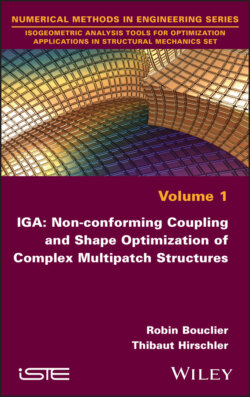Читать книгу IGA - Robin Bouclier - Страница 34
1.5.3. Mortar coupling
ОглавлениеA second option to weakly formulate the coupling problem [1.35]-[1.36] is to resort to the class of Lagrange multiplier methods. We note that the Lagrange multiplier approach is also often referred to as the Mortar approach in literature (Wohlmuth 2000; Brivadis et al. 2015; Dornisch et al. 2015; Zou et al. 2018; Wunderlich et al. 2019). We will use the two terminologies indifferently in the whole document. In this context, a mixed formulation is set up to impose the coupling constraints [1.36]. Classically, a single Lagrange multiplier λ ∈ (where is an appropriate space) is introduced, as the dual unknown, to represent both of the interface traction forces, i.e. −σ1n1 = σ2n2 = −λ in equation [1.36b]. Then, the interface Dirichlet condition [1.36a] is imposed in a weak sense over Γ, using the Lagrange multiplier. This leads to the formulation of the following Lagrangian of the coupled problem:
[1.41]
where the bilinear form b is defined such that:
[1.42]
With the above developments, we can finally obtain the classical Mortar coupling formulation of the reference problem as follows: find (u1, u2, λ) ∈ 1 × 2 × M such that:
[1.43a]
[1.43b]
[1.43c]
Thanks to the additional Lagrange multiplier field, the formulation is time variationally consistent. Moreover, the practical advantage of such a mixed formalism is that it enables us to keep the stiffness operators associated with the sub-domains separated and unmodified. Indeed, the communication between the sub-domains is performed via the Lagrange multiplier only. This feature is the basis of the non-overlapping domain decomposition methods developed for high-performance computing on parallel computer architectures (Farhat and Roux 1991; Farhat et al. 2001; Stefanica 2001, 2005; Gosselet and Rey 2006; Kleiss et al. 2012). Drawing inspiration from these techniques, in Chapter 3 we will develop a family of efficient algorithms for non-conforming isogeometric multipatch analysis. As of now, it may be quoted that system [1.43] will not be solved directly, but in an iterative way through the resolution of several local symmetric positive definite systems. Using the same idea, the additional field also enables us to simply build non-invasive coupling algorithms for multiscale computations: several different numerical models along with their related numerical codes can be coupled iteratively with the exchange of interface data only (Passieux et al. 2013; Guguin et al. 2014; Duval et al. 2016; Guinard et al. 2018). This opportunity will be investigated in Chapter 2 for global/local IGA. However, formulation [1.43] represents a saddle point problem, meaning that special care may be required for the construction of the approximation space of to avoid undesirable energy-free oscillations, due to the non-satisfaction of the inf–sup condition (see, for example, Ben Belgacem and Maday (1997) and Wohlmuth (2000, 2001) for the context of standard FEM and Brivadis et al. (2015) and Dittmann et al. (2019) for IGA). At this stage, we do not go into further detail and indicate that the Mortar coupling strategy will be discussed in Chapters 2 and 3.
NOTE.– In the context of Mortar approaches in IGA, it may be noted that a special interest is currently devoted to the dual Mortar resolution version (see, for example, Dornisch et al. (2015, 2017), Seitz et al. (2016), Zou et al. (2018) and Wunderlich et al. (2019)). The principle of this subclass of methods is to use dual-basis functions based on a biorthogonality concept to approximate , which allows for an easy elimination of the additional Lagrange multiplier DOF from the global system [1.43]. It results in a condensed coupled system that is positive definite and merges the stiffness operators of the two sub-domains. In this work, we follow another path for the resolution, as mentioned above: we benefit from the additional Lagrange multiplier field to develop high-performance computing and non-invasive tools, which appears original in the area of IGA.
